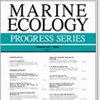对粪便的 DNA 分析揭示了港海豹饮食多样性的时空结构,包括从当地海豹栖息地到海洋生物区的多样性
IF 2.1
3区 环境科学与生态学
Q2 ECOLOGY
引用次数: 0
摘要
摘要:捕食影响着生态系统,而量化捕食对猎物分布和丰度的影响需要在适当的时空尺度上进行大量工作,以估算捕食者的食量。在此,我们介绍了一种海洋捕食者(港海豹 Phoca vitulina richardsi)的食量估计,这些数据来自 2015 年至 2019 年期间在加拿大不列颠哥伦比亚省温哥华岛周围的乔治亚海峡和其他沿海地区的多个集群点(n = 64)采样的粪便收集(n = 3420)。DNA 代谢编码和硬质部分分析分别用于确定消耗的猎物物种的比例和大小。我们发现,海豹消耗了62种主要猎物。食物的多样性受采集样本数量的影响很大,在小的空间尺度(集群地)和大的生物区域之间存在差异。根据地点、季节和年份的不同,有三到五种物种成为海豹的主要食物,包括太平洋无须鳕(Merluccius productus)、太平洋鲱鱼(Clupea pallasii)和马眼狭鳕(Gadus chalcogrammus)。在佐治亚海峡,雄性海豹和雌性海豹在太平洋无须鳕和马眼狭鳕较多的地区和季节捕食得更多。海豹捕食的猎物大小范围很广,而且因物种、季节和地区而异。这些结果表明,海豹觅食受到当地猎物丰度和组成的影响。如果不考虑食性的空间和时间变化,试图模拟捕食对相关物种的影响就有可能使其估计值出现偏差,并且无法充分反映不确定性。本文章由计算机程序翻译,如有差异,请以英文原文为准。
DNA analysis of scats reveals spatial and temporal structure in the diversity of harbour seal diet from local haulouts to oceanographic bioregions
ABSTRACT: Predation shapes ecosystems, and quantifying the impacts of predation on the distribution and abundance of prey requires substantial effort at appropriate spatial and temporal scales for diet estimation of predators. Here, we present diet estimates of a marine predator (harbour seal Phoca vitulina richardsi) from scat collections (n = 3420) sampled at multiple haulout sites (n = 64) in the Strait of Georgia and other coastal regions around Vancouver Island, British Columbia, Canada, between 2015 and 2019. DNA metabarcoding and hard part analysis were used to identify the proportion and sizes of prey species consumed, respectively. We found that harbour seals consumed 62 primary prey species. Diversity in the diet was highly affected by the number of samples collected and varied at small spatial scales (haulout sites) as well as among broad bioregions. Three to 5 species dominated the diet depending on location, season, and year, including Pacific hake Merluccius productus, Pacific herring Clupea pallasii, and walleye pollock Gadus chalcogrammus. Within the Strait of Georgia, both male and female harbour seals consumed more hake and walleye pollock in areas and seasons in which they were more abundant. Harbour seals consumed a wide size range of prey that also varied by species, season, and region. These results indicate that harbour seal foraging is influenced by both the local abundance and composition of prey. Attempts to model the impact of predation on species of concern risk bias in their estimates and underrepresenting uncertainty if spatial and temporal variation in the diet is not accounted for.
求助全文
通过发布文献求助,成功后即可免费获取论文全文。
去求助
来源期刊

Marine Ecology Progress Series
环境科学-海洋学
CiteScore
5.30
自引率
8.00%
发文量
238
审稿时长
3 months
期刊介绍:
The leading journal in its field, MEPS covers all aspects of marine ecology, fundamental and applied. Topics covered include microbiology, botany, zoology, ecosystem research, biological oceanography, ecological aspects of fisheries and aquaculture, pollution, environmental protection, conservation, and resource management.
 求助内容:
求助内容: 应助结果提醒方式:
应助结果提醒方式:


